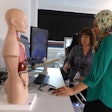A major contributor to preventable medical errors is communication breakdown between managing and consulting physicians -- and many of these errors can be traced to radiology reports, according to a new study published in the June issue of Clinical Radiology. But what remains unclear is whether these errors are due to referring clinicians' faulty recall, radiologists' communication, or both.
Not only can these communication delays and errors negatively affect patient care, but also they are major sources of litigation involving radiology in the U.S., researchers at Columbia University in New York City wrote.
Lead study author Dr. Marcel Brus-Ramer, PhD, and colleagues found that in nearly one in seven cases, nonradiologist physicians reported that inpatient management could have been or had been affected by differences between their recall of radiological results and the actual report (Clinical Radiology, June 2012, Volume 67:6, pp. 574-578).
There are many reports of problems in communication of patient information among physicians, according to the study team: Discharge summaries from in-hospital physicians intended for primary care physicians are often not transmitted within appropriate time frames; information gaps (that is, previously collected but currently unavailable information) occur in nearly one-third of emergency room cases; significant numbers of abnormal imaging results remain "lost to follow-up."
Less understood is whether distortion of the information in radiographic reports occurs during person-to-person transmission within the medical team, or during the recall of the information by the managing physician, they noted.
Each weekday between 1 July and 30 August 2009, the group used the New York Presbyterian Hospital/Columbia University Medical Center's department of radiology's PACS to identify inpatients who had had CT or MRI exams of the chest, abdomen, or pelvis in the prior two to four days, who remained as inpatients on the day of the survey, and whose studies had reports signed by attending radiologists published in the electronic medical record (EMR). The team then conducted structured telephone surveys with the house staff managing these patients.
Fifty-six physicians were surveyed regarding 98 patient cases. Of the physicians contacted, 79% were in medical specialties and 21% were in surgical specialties, according to Brus-Ramer's team.
Each physician was asked:
- How he or she first became aware of the results of the imaging study (via another member of house staff team, by reading the EMR, through direct communication by telephone or with a radiologist, or by interpreting the results independently)
- To recall the substance of radiological interpretation and to compare it with the "impression" section of the radiology report
- To assess the level of difference between the interpretations and whether management was affected
The authors found that physicians most frequently obtained radiological information from the EMR (43.9%), while the other methods of obtaining the results were used in roughly equal frequency (via house staff, 17.3%, through direct communication by telephone or with a radiologist, 18.4%, or through interpreting the results independently, 20.4%). None of the physicians reported being unaware of the imaging results.
Surveyed physicians reported that there were no differences between their recalled results and the "Impression" section of the published report in 44.9% of cases -- or only minor differences in wording in 40.8% of cases. But they also stated that patient management could have been or had already been affected by results discrepancies in 11.2% and 3.1% of cases, respectively. Together, in nearly 15% of cases, physicians stated that differences between the recalled results and the official radiology report results were of sufficient magnitude to change or potentially alter patient management.
Significant errors included lack of recall of a clinical diagnosis, of a diagnosis that was ruled out and needed follow-up, and of a difference in the severity of a disease process and its treatment, according to the study team. Causes for these errors included:
- Differences between radiologists' initial oral reports and their final reports
- Clinicians' inability to remember all significant findings from radiology reports
- Radiologists' inability to effectively communicate results orally
- Clinicians' inability to recall all clinically significant findings communicated orally or electronically by radiologists
Because most physicians acquired imaging exam information via the EMR, and the surveys were conducted at a time when a finalized radiology report would be available, it's most likely that faulty recall of results had an important effect on the error rate, and further studies are needed.
"[Future research may determine the] relationship between communication errors and direct communication with a radiologist, and whether such errors are primarily due to faulty recall, faulty understanding of the consultation, or differences between the radiologists' explanations and the official report," the authors wrote.














